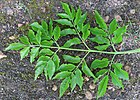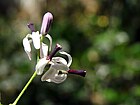Note: This is a project under development. The articles on this wiki are just being initiated and broadly incomplete. You can Help creating new pages.
Difference between revisions of "Melia azedarach"
| Line 1: | Line 1: | ||
| − | + | [[File:Melia azedarach inflorescences 7th Brigade Park Chermside L1080769.jpg|thumb|right|'' Melia azedarach'']] | |
| + | '''Melia azedarach''', commonly known as the chinaberry tree, Pride of India, bead-tree, Cape lilac, syringa berrytree, Persian lilac, Indian lilac, or white cedar, is a species of deciduous tree in the mahogany family, Meliaceae, that is native to Indomalaya and Australasia. | ||
| + | |||
| + | |||
==Uses== | ==Uses== | ||
| − | {{Uses| | + | {{Uses|antioxidative, analgesic}}, {{Uses|anti-Inflammatory, insecticidal}},{{Uses|rodenticidal, antidiarrhoeal}},{{Uses|deobstruent, diuretic}},{{Uses|antidiabetic, cathartic}}. |
==Parts Used== | ==Parts Used== | ||
| − | + | {{Parts Used|leaves}}. | |
==Chemical Composition== | ==Chemical Composition== | ||
| + | Azedarach including Flavonoid, phytosterols, Diterpene, alkane hydrocabon, n-alkanoic acid, vitamin-E and Tri-terpene, Terpene alcohol. ... A new limonoid, two new anthraquinones and a new glycosyl derivative of ellagic acid were isolated and identified in the roots of Melia composita. | ||
<ref name="chemical composition"/> | <ref name="chemical composition"/> | ||
==Common names== | ==Common names== | ||
| − | {{Common names | + | {{Common names|kn=|ml=Kalathi,Kadali,Athirani,Thodukkara,Kalampotti|sa=|ta=|te=|hi=|en=Malabar Melastome, Indian-rhododendron}} |
==Properties== | ==Properties== | ||
Reference: Dravya - Substance, Rasa - Taste, Guna - Qualities, Veerya - Potency, Vipaka - Post-digesion effect, Karma - Pharmacological activity, Prabhava - Therepeutics. | Reference: Dravya - Substance, Rasa - Taste, Guna - Qualities, Veerya - Potency, Vipaka - Post-digesion effect, Karma - Pharmacological activity, Prabhava - Therepeutics. | ||
===Dravya=== | ===Dravya=== | ||
| + | |||
===Rasa=== | ===Rasa=== | ||
| − | |||
===Guna=== | ===Guna=== | ||
| Line 29: | Line 33: | ||
==Habit== | ==Habit== | ||
| − | {{Habit|}} | + | {{Habit|Tree}} |
==Identification== | ==Identification== | ||
===Leaf=== | ===Leaf=== | ||
| − | {{Leaf|||}}<ref name="Leaf"/> | + | {{Leaf|Simple|Alternate|The leaves are light green and feathery with a bipinnate pattern}}<ref name="Leaf"/> |
===Flower=== | ===Flower=== | ||
| − | {{Flower||||}} | + | {{Flower|Unisexual|1 inch|Light blue|5|Flowers Season is June - August}} |
| − | |||
| − | |||
===Other features=== | ===Other features=== | ||
==List of Ayurvedic medicine in which the herb is used== | ==List of Ayurvedic medicine in which the herb is used== | ||
| + | * [[Vishatinduka Taila]] as ''root juice extract'' | ||
==Where to get the saplings== | ==Where to get the saplings== | ||
| − | |||
==Mode of Propagation== | ==Mode of Propagation== | ||
| − | {{Propagation|}} | + | {{Propagation|roots}}. |
==How to plant/cultivate== | ==How to plant/cultivate== | ||
| + | Although successful vegetative propagation through stem cuttings, root suckers and air layering has been reported, propagation is usually by seed. Drupes need to be macerated until the seed can be gently eased out. Seeds are soaked in water for 1-2 days, depulped, and dried in the shade. They can be stored in a cool and well-ventilated place, in cloth or gunny bags. Plastic and other airtight containers should not be used for seed storage. Seed should be planted within two weeks after harvesting, as viability drops rapidly thereafter. Sowing is mostly done in a nursery at 15 cm × 2.5 cm in a sunny place, keeping the seed lightly covered with soil or mulch. Seedlings may be thinned to 15 cm × 15 cm when 2 months old, and transplanted when 7-10 cm tall. | ||
<ref name="How to plant/cultivate"/> | <ref name="How to plant/cultivate"/> | ||
==Commonly seen growing in areas== | ==Commonly seen growing in areas== | ||
| − | {{Commonly seen| | + | {{Commonly seen|Meadows}}. |
==Photo Gallery== | ==Photo Gallery== | ||
<gallery class="left" caption="" widths="140px" heights="140px"> | <gallery class="left" caption="" widths="140px" heights="140px"> | ||
| + | File:Melia azedarach doubly imparipinnate compound leaf IMG 2096c.jpg | ||
| + | File:Melia Dubia Synonym Melia Composita.jpg | ||
| + | File:Melia azedarach inflorescences 7th Brigade Park Chermside P1010598.jpg | ||
</gallery> | </gallery> | ||
==References== | ==References== | ||
| + | |||
<references> | <references> | ||
| + | <ref name="chemical composition">[https://www.hindawi.com/journals/ecam/2012/258434/ Chemical constituents]</ref> | ||
| − | <ref name=" | + | <ref name="Leaf">[https://indiabiodiversity.org/species/show/246672 Plant description]</ref> |
| − | <ref name=" | + | <ref name="How to plant/cultivate">[https://uses.plantnet-project.org/en/Melia_azedarach_(PROSEA) Cultivation"]</ref> |
| + | </references> | ||
| − | |||
| − | |||
| − | |||
==External Links== | ==External Links== | ||
| − | * [ ] | + | * [https://indiabiodiversity.org/species/show/246672 Melastoma malabathricum] |
| − | + | ||
| − | + | ||
[[Category:Herbs]] | [[Category:Herbs]] | ||
| − | |||
Revision as of 14:07, 1 June 2020
Melia azedarach, commonly known as the chinaberry tree, Pride of India, bead-tree, Cape lilac, syringa berrytree, Persian lilac, Indian lilac, or white cedar, is a species of deciduous tree in the mahogany family, Meliaceae, that is native to Indomalaya and Australasia.
Contents
- 1 Uses
- 2 Parts Used
- 3 Chemical Composition
- 4 Common names
- 5 Properties
- 6 Habit
- 7 Identification
- 8 List of Ayurvedic medicine in which the herb is used
- 9 Where to get the saplings
- 10 Mode of Propagation
- 11 How to plant/cultivate
- 12 Commonly seen growing in areas
- 13 Photo Gallery
- 14 References
- 15 External Links
Uses
antioxidative, analgesic, anti-Inflammatory, insecticidal,rodenticidal, antidiarrhoeal,deobstruent, diuretic,antidiabetic, cathartic.
Parts Used
Chemical Composition
Azedarach including Flavonoid, phytosterols, Diterpene, alkane hydrocabon, n-alkanoic acid, vitamin-E and Tri-terpene, Terpene alcohol. ... A new limonoid, two new anthraquinones and a new glycosyl derivative of ellagic acid were isolated and identified in the roots of Melia composita.
Common names
| Language | Common name |
|---|---|
| Kannada | |
| Hindi | |
| Malayalam | Kalathi,Kadali,Athirani,Thodukkara,Kalampotti |
| Tamil | |
| Telugu | |
| Marathi | NA |
| Gujarathi | NA |
| Punjabi | NA |
| Kashmiri | NA |
| Sanskrit | |
| English | Malabar Melastome, Indian-rhododendron |
Properties
Reference: Dravya - Substance, Rasa - Taste, Guna - Qualities, Veerya - Potency, Vipaka - Post-digesion effect, Karma - Pharmacological activity, Prabhava - Therepeutics.
Dravya
Rasa
Guna
Veerya
Vipaka
Karma
Prabhava
Habit
Identification
Leaf
| Kind | Shape | Feature |
|---|---|---|
| Simple | Alternate | The leaves are light green and feathery with a bipinnate pattern |
Flower
| Type | Size | Color and composition | Stamen | More information |
|---|---|---|---|---|
| Unisexual | 1 inch | Light blue | 5 | Flowers Season is June - August |
Other features
List of Ayurvedic medicine in which the herb is used
- Vishatinduka Taila as root juice extract
Where to get the saplings
Mode of Propagation
How to plant/cultivate
Although successful vegetative propagation through stem cuttings, root suckers and air layering has been reported, propagation is usually by seed. Drupes need to be macerated until the seed can be gently eased out. Seeds are soaked in water for 1-2 days, depulped, and dried in the shade. They can be stored in a cool and well-ventilated place, in cloth or gunny bags. Plastic and other airtight containers should not be used for seed storage. Seed should be planted within two weeks after harvesting, as viability drops rapidly thereafter. Sowing is mostly done in a nursery at 15 cm × 2.5 cm in a sunny place, keeping the seed lightly covered with soil or mulch. Seedlings may be thinned to 15 cm × 15 cm when 2 months old, and transplanted when 7-10 cm tall. [3]
Commonly seen growing in areas
Meadows.
Photo Gallery
References
External Links
- Ayurvedic Herbs known to be helpful to treat antioxidative, analgesic
- Ayurvedic Herbs known to be helpful to treat anti-Inflammatory, insecticidal
- Ayurvedic Herbs known to be helpful to treat rodenticidal, antidiarrhoeal
- Ayurvedic Herbs known to be helpful to treat deobstruent, diuretic
- Ayurvedic Herbs known to be helpful to treat antidiabetic, cathartic
- Herbs with leaves used in medicine
- Herbs with common name in Malayalam
- Herbs with common name in English
- Habit - Tree
- Index of Plants which can be propagated by roots
- Herbs that are commonly seen in the region of Meadows
- Herbs



